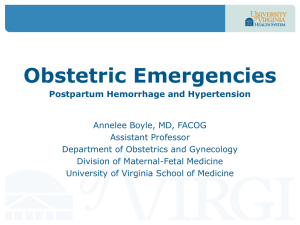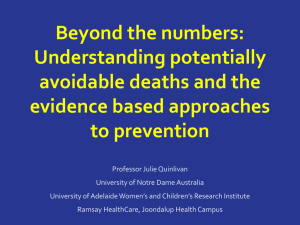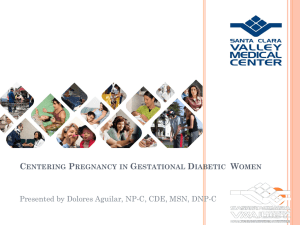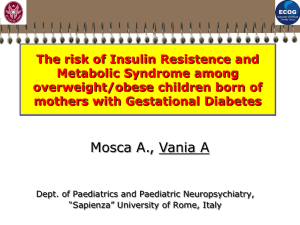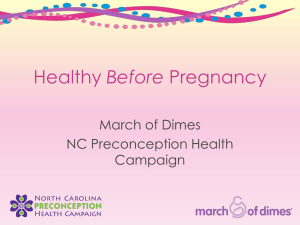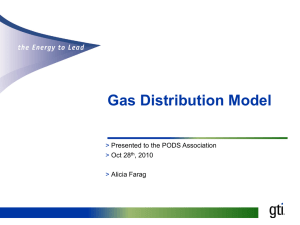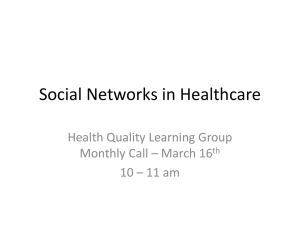Intervention - National Women`s Hospital
advertisement
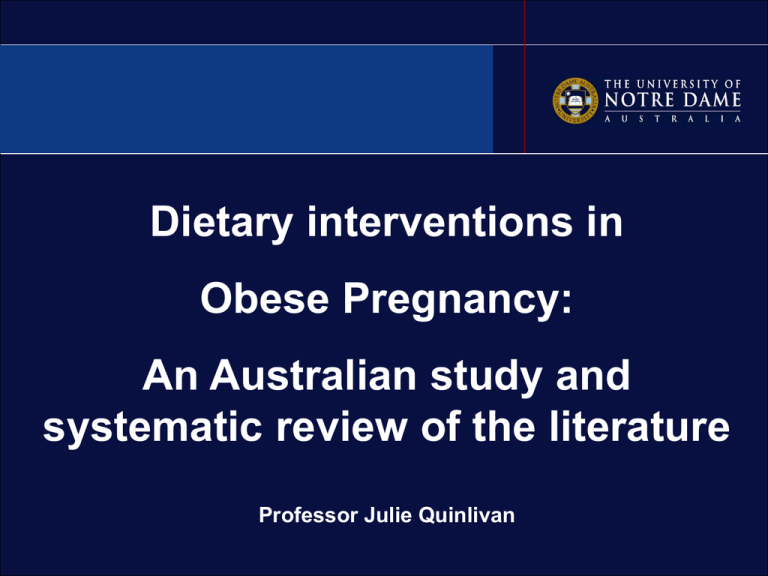
Dietary interventions in Obese Pregnancy: An Australian study and systematic review of the literature Professor Julie Quinlivan Prevalence In Australia and New Zealand, 35% of women presenting for antenatal care are overweight or obese Ball K et al, Pub Hlth Nutr 2003; Lederman SA. Obstet Gynecol 1993; Gunderson & Abrams Epidemiol Rev 2000. Prevalence So we have more women than ever PRESENTING for antenatal care who are overweight or obese This is then compounded by women PUTTING ON more weight in pregnancy than required. Ball K et al, Pub Hlth Nutr 2003; Lederman SA. Obstet Gynecol 1993; Gunderson & Abrams Epidemiol Rev 2000. 2. Increasing weight gain in pregnancy Period Mean weight gain in pregnancy 1960-1970 8.5-10kg 1980-1990 9-11kg 1990-2000 10-14kg 2000-2010 13-15kg The excess weight gain in pregnancy is FAT women must lose afterwards. NHMRC (Australia) Clinical Practice Guidelines for the management of overweight and obesity in adults, Commonwealth of Australia, Canberra, 2003.; Lederman SA. Obstet Gynecol 1993; 82: 148-55; Hytten and Chamberlerein , Clinical psychology in Obstetrics. Blackwell Scientific Publications: Oxford, 1980; Linne Y. Obesity reviews 2004; Chesley and Weight changes and water balance in normal and toxic pregnancy. Am J Obstet Gynecol 1944; 48: 565-593. Bongain , Euro J Obstet Gynaecol Repro Biol 1998. NHMRC (Aust) reports that young adult women are at particular risk of weight gain. Childbirth is a particular risk. Up to 20% of women gain >5kg by 6 months postpartum. Ball K et al, Pub Hlth Nutr 2003; Lederman SA. Obstet Gynecol 1993; Gunderson & Abrams Epidemiol Rev 2000. Ref: 2B blog spot.com Implications of obesity Increased pre-pregnancy weight and weight gain during pregnancy ADVERSELY increases: * Gestational diabetes; * Macrosomia; * Preterm; * Postdates; * Operative delivery; * Hypertension; * Infections; * Clotting disorders. Example: GDM What is the impact of maternal BMI on GDM? Rate of GDM 25-30 31-40 40+ 2-5% 7-12% 17-25% The obesity epidemic and an increase in pregnancy weight gain have increased gestational diabetes..... .....and then, along comes evidence that we have been under diagnosing gestational diabetes to the detriment of women and their babies. HAPO Hyperglycaemia and Adverse Pregnancy Outcomes study. It found that there was a CONTINUOUS relationship between blood glucose and adverse neonatal and maternal outcomes. The trial suggested that new guidelines were required to diagnose GDM. Cur Opinion Obstet Gynecol 2011; 23(2): 72-5. The Randomised trials Two large RCT implementing treatment at old diagnostic criteria for GDM versus the new HAPO criteria for GDM Both RCT found SIGNIFICANT IMPROVEMENTS in MATERNAL and NEONATAL outcomes with the treatment of GDM under the new HAPO guidelines. Cur Opinion Obstet Gynecol 2011; 23(2): 72-5. Significant improvements Birth weight >90th centile Cord blood C-peptide >90th centile Caesarean section Neonatal hypoglycaemia Pre eclampsia Preterm birth Shoulder dystocia Birth injury NICU admission Hyperbilirubinaemia Annals New York Acad Science 2010; 1205:88-93 Post HAPO International association of diabetes and pregnancy study groups (IADPSG) recommendation: All pregnant women should be offered a 75g oral GTT between 24-28 weeks gestation. An ABNORMAL result is any one of the following: Fasting 5.1 g/dL (92mg/dL) 1 hr 10.0 g/dL (180mg/dL) 2 hr 8.5 g/dL (153mg/dL) New guidelines and workload All GTT results from SW and N/Sydney analysed by old and HAPO criteria. They found an INCREASE in workload 29-32% ANZJOG 2010; 50(5): 439-43. Options So we need interventions in pregnancy directed towards obese women that aim to restrict weight gain in pregnancy to IOL recommendations and try to reverse the increase in GDM. Target weight gains New Institute of Medicine 2009 guidelines for weight gain in pregnancy Overweight women BMI 25 to 29.9 6.8 to 11.3kg Obese women BMI >30 4.9 to 9kg Options * Exercise X * Psychological X * Diet ???? Aim Does a 4-step multidisciplinary approach to the management of obese pregnant women reduce weight gain and gestational diabetes in obese pregnant women? Quinlivan JA et al, ANZJOG 2011 . Triangle of intervention HIGH LOW The 4 steps 1. Continuity of care; 2. Measure Weight gain at each visit; 3. Repeated short interventions by a food technologist; 4. An initial assessment by a clinical psychologist Hypotheses The 4-step approach would reduce the incidence of gestational diabetes; The reduction in gestational diabetes would be mediated through a reduction in maternal weight gain in pregnancy; and This would occur without an impact upon birth weight. Controls Routine antenatal care. This consisted of midwifery, obstetrician and general practitioner antenatal clinics, with access to high-risk antenatal clinics if indicated on medical grounds. Intervention Women in the intervention group attended a study-specific antenatal clinic which differed in routine care only in the following four steps. All other clinic protocols across control and intervention clinics were identical and followed The Three Centre Consensus Statement on Maternity Care Outcome data Variables GDM (%) Intervention 6 Control 29 P-value 0.04 Weight gain (kg) 7.0 (0.65) 13.8 (0.67) <0.001 Birthweight 3.5 (0.07) 3.4 (0.10) 0.162 Outcome data Variables GDM (%) Intervention 6 Control 29 P-value 0.04 Weight gain (kg) 7.0 (0.65) 13.8 (0.67) <0.001 Birthweight 3.5 (0.07) 3.4 (0.10) 0.162 IOL : Obese women 4.9 to 9kg Diet changes Variables (N) Fizzy drinks Water Fast food Home cooked meal Fresh fruit Fresh vegetable First visit (N=63) 61 2 40 23 5 11 Final visit (N=63) 23 47 21 42 42 42 Quinlivan et al, 2011 Australia EFFECTIVE 1. Continuity of care 2. Weigh at every antenatal visit 3. Short visit with nutritionist (5 minutes) to review: • What did the patient eat the day before? • Immediate written feedback on diet 4. Psychological assessment and intervention if required. What do other RCT in the literature show? Is there a pattern? Can we develop an even simpler intervention that works? All RCT There are currently FOUR RCT of dietary interventions in obese pregnant women. 1. Wolff et al. (2008) Denmark 2. Thornton et al. (2009) USA 3. Guelinckx et al. (2010) Belgium 4. Quinlivan et al, 2011 Australia Wolff et al. (2008) Denmark 1. Weight at every antenatal visit and discussion of weight gain by the provider 2. One hour visit with a dietician followed by 9 x 30 minute visits. Total of 10 visits. REPEATED INTERVENTION EFFECTIVE Thornton et al. (2009) USA 1. Continuity of care 2. Initial visit by dietician. 3. Food diary maintained by patient and discussed at every antenatal visit by providers. REPEATED INTERVENTION EFFECTIVE Guelinckx et al. (2010) Belgium 1. Continuity of care 2. Single visit by a dietician. SINGLE INTERVENTION NOT EFFECTIVE Quinlivan et al, 2011 Australia REPEATED INTERVENTION EFFECTIVE Meta analysis – Impact upon maternal weight gain Study N, mean N, mean % (SD); Treatment (SD); Control Weight 9.36 ID WMD (95% CI) Wolff et al. (2008) -6.70 (-10.27, -3.13) 23, 6.6 (5.5) 28, 13.3 (7.5) Thornton et al. (2009) -9.10 (-10.93, -7.27) 116, 5 (6.8) 116, 14.1 (7.4) 35.75 Guelinckx et al. (2010) -0.80 (-3.30, 1.70) 65, 9.8 (7.6) 65, 10.6 (6.9) 19.20 Quinlivan et al. (2011) -6.80 (-8.63, -4.97) 63, 7 (5.2) 61, 13.8 (5.2) 35.68 Overall (I-squared = 89.3%, p = 0.000) -6.46 (-7.55, -5.37) 267 270 100.00 -10.9 0 Treatment reduces weight gain 10.9 Treatment increases weight gain Meta analysis – Impact upon maternal weight gain Study N, mean N, mean % (SD); Treatment (SD); Control Weight 9.36 ID WMD (95% CI) Wolff et al. (2008) -6.70 (-10.27, -3.13) 23, 6.6 (5.5) 28, 13.3 (7.5) Thornton et al. (2009) -9.10 (-10.93, -7.27) 116, 5 (6.8) 116, 14.1 (7.4) 35.75 Guelinckx et al. (2010) -0.80 (-3.30, 1.70) 65, 9.8 (7.6) 65, 10.6 (6.9) 19.20 Quinlivan et al. (2011) -6.80 (-8.63, -4.97) 63, 7 (5.2) 61, 13.8 (5.2) 35.68 Overall (I-squared = 89.3%, p = 0.000) -6.46 (-7.55, -5.37) 267 270 100.00 -10.9 0 Treatment reduces weight gain 10.9 Treatment increases weight gain The future intervention 1. The intervention needs to be repeated. 2. The intervention can be short. 3. The intervention should include a written element retained by the woman. 4. The intervention can be undertaken by anyone in the care team. A 3 step model Step 1: Continuity of care; Step 2: Weight at every antenatal visit; Step 3: Repeated review by the ANC provider of a DIETARY DIARY. The Diary RCT Enrole: Women presenting <20 weeks with a BMI>25 Intervention 3 step model versus existing model of care 10 Outcomes: * Reduce gestational weight gain * Reduce gestational diabetes (15% to 10%) Sample size: N=1450 The DIARY trial Key elements of the diary... 1. The 3 Do. 2. The 3 Don’t. 3. Diary pages where the patient writes in the previous day’s food and drink intake. 4. Space for care provider to provide written feedback at each ANC. Do and Don’t 3 Do... •Drink water •Eat fresh vegetables •Eat home cooked meals 3 Don’t... •Smoke •Drink alcohol •Drink fizzy drinks, cordial and juices Thankyou
